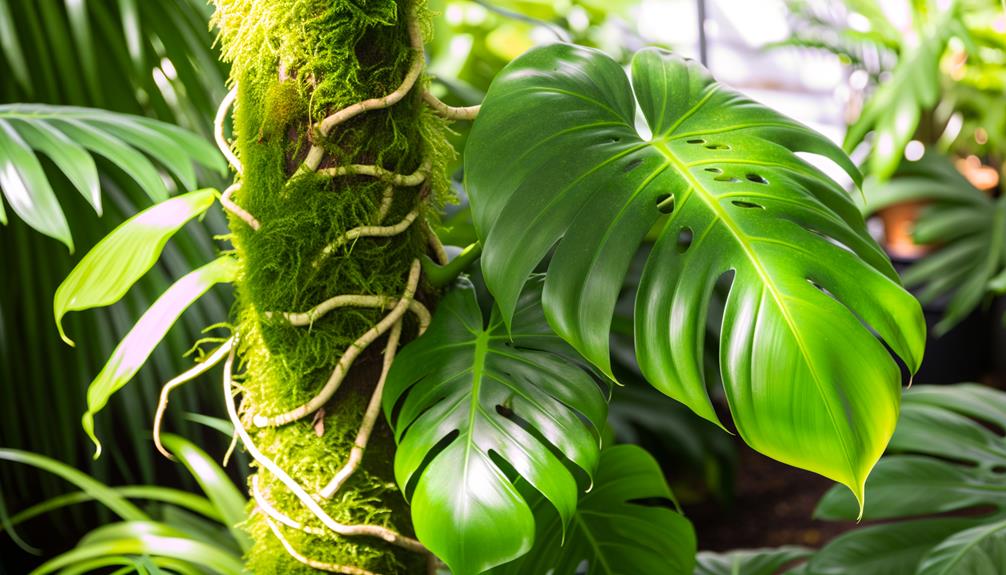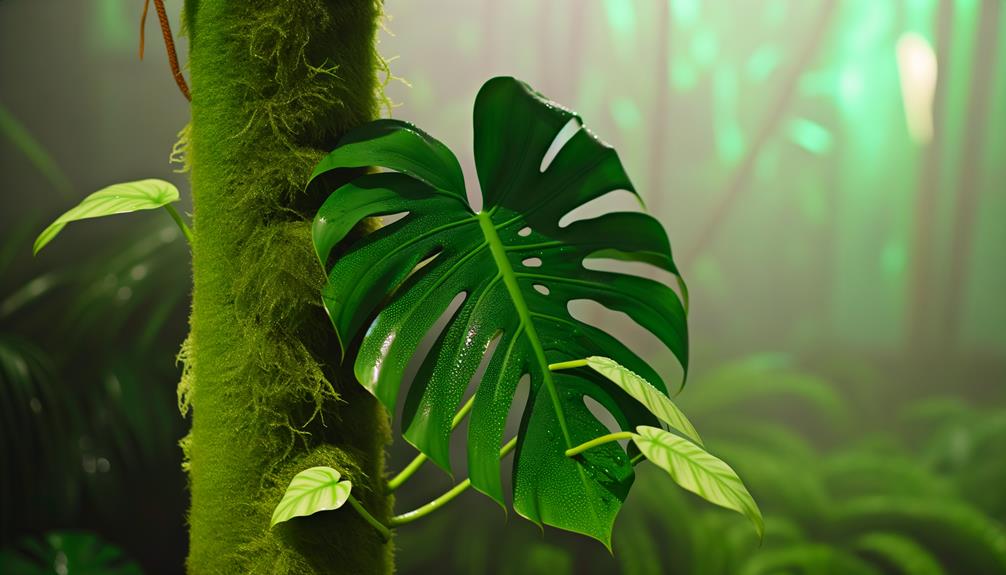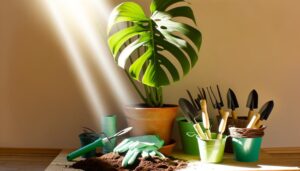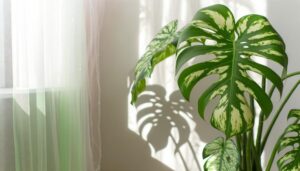Monstera Peru on Moss Pole
Using a moss pole for your Monstera Peru enhances structural strength, mirroring its natural climbing behavior. Choose resilient materials like sphagnum moss for moisture retention or coco coir for longevity.
Make sure the pole is at least 1.5 times the plant's height and securely anchored in the potting medium. Soak the moss, wrap it snugly around the support structure, and use ties to secure the stems.
Guide each node to touch the damp surface of the moss pole, promoting effective aerial root development. Regular adjustments and maintaining moisture levels are essential for ideal growth.
Explore more advanced techniques and tips.

Key Takeaways
- Guide Monstera Peru stems towards the moss pole, ensuring each node contacts the moist surface for optimal growth.
- Use soft ties or clips to secure Monstera Peru stems to the moss pole, adjusting them regularly.
- Choose a moss pole with sphagnum moss for moisture retention or coco coir for durability to support Monstera Peru.
- Position the moss pole centrally in the pot and compact the surrounding potting medium for stability and support.
- Maintain the moisture levels of the moss pole to encourage effective aerial root development in Monstera Peru.
Benefits of a Moss Pole

Utilizing a moss pole for your Monstera Peru can enhance the plant's structural integrity and promote vertical growth, optimizing photosynthetic efficiency. The moss pole provides a stable support system, mimicking the natural habitat of Monstera species, which typically climb trees.
This vertical orientation encourages the plant to produce larger, more mature leaves, thereby increasing its overall photosynthetic capacity. Additionally, as the aerial roots attach to the moss pole, they absorb moisture and nutrients more effectively, ensuring robust growth.
The moss pole also helps in reducing plant stress by distributing weight evenly and preventing stem breakage. Consequently, your Monstera Peru becomes less prone to pest infestations and diseases, leading to a healthier, more vibrant plant.
Choosing the Right Moss Pole
When selecting a moss pole for your Monstera Peru, consider the material's durability to guarantee it supports the plant's aerial roots effectively. Evaluate the pole's height and stability to match the Monstera's growth potential and prevent tipping. Choose poles made from materials like sphagnum moss or coco coir, which offer ideal moisture retention and root adherence.
Remember to consider the overall aesthetics of the moss pole since it will be a visible part of your plant display. Additionally, check the diameter of the pole to ensure it provides enough surface area for the Monstera's roots to cling onto as it grows. Lastly, assess the overall quality of the moss pole to ensure it will last long-term and provide continuous support for your Monstera Peru.
Material and Durability
Selecting the right moss pole for your Monstera Peru involves evaluating materials like sphagnum moss and coco coir for their moisture retention, structural integrity, and longevity. Both materials offer distinct advantages that cater to specific plant needs.
Sphagnum moss excels in moisture retention, providing a humid microenvironment beneficial for aerial roots.
Coco coir, with its fibrous structure, offers enhanced durability and better airflow, reducing the risk of mold growth.
Key considerations include:
- Moisture Retention: Sphagnum moss retains water well, essential for tropical plants.
- Structural Integrity: Coco coir maintains shape longer under varying conditions.
- Longevity: Sphagnum moss may degrade faster, whereas coco coir lasts longer.
- Airflow: Coco coir allows better ventilation, preventing root rot.
- Availability: Both materials are widely accessible but may vary by region.
Height and Stability
After determining the best material for your moss pole, it's essential to think about the height and stability to guarantee your Monstera Peru can climb and thrive effectively. Opt for a pole at least 1.5 times the height of your plant to accommodate growth.
Stability is vital; make sure the moss pole is firmly anchored in the potting medium to prevent toppling. A wider base can provide additional support. Consider the tensile strength of the pole's core material to handle the plant's weight as it matures.
Additionally, securing the pole with ties or clips can enhance stability without harming the plant. These measures guarantee your Monstera Peru benefits from vertical growth, optimizing photosynthesis and overall health.
Setting Up the Moss Pole

To set up the moss pole, gather your materials, including sphagnum moss, a strong support structure, and binding ties for secure attachment.
Begin by soaking the sphagnum moss in water until it's thoroughly moistened. Then, wrap the moss tightly around the support structure, ensuring uniform coverage.
Next, use binding ties to secure the moss in place. Confirm the moss pole is firmly inserted into the pot to prevent instability.
Materials needed:
- Sphagnum moss
- Robust support structure
- Binding ties
- Water
- Potting medium
Position the moss pole centrally in the pot, ensuring it reaches the bottom for best stability. Finally, compact the surrounding potting medium to anchor the pole securely.
This setup creates an ideal environment for your Monstera Peru.
Training Monstera Peru to Climb
Begin by gently guiding the stems of your Monstera Peru towards the moss pole, ensuring each node makes contact with the moist surface to encourage root attachment. Secure the stems using soft ties or plant clips to avoid damaging the delicate tissue. Regularly check the attachment points and adjust as necessary to accommodate growth. It's essential to maintain the moss pole's moisture, as dry moss won't support aerial root development effectively.
| Step | Description |
|---|---|
| Positioning | Align stems with the moss pole |
| Securing | Use soft ties or clips to attach stems |
| Monitoring | Regularly check and adjust attachment points |
| Moisture | Keep the moss pole consistently moist |
Watering and Humidity Needs

Maintaining ideal moisture levels and humidity is crucial for the health and growth of your Monstera Peru. Water the plant when the top 1-2 inches of soil feel dry. Promote proper drainage to prevent waterlogging, which can result in root rot.
Monstera Peru thrives in humid environments, ideally between 60-80% relative humidity. Use a hygrometer to monitor levels and employ a humidifier if necessary.
To maintain prime conditions:
- Avoid letting the soil dry out completely.
- Mist the leaves regularly to replicate natural humidity.
- Place the plant on a tray filled with pebbles and water for passive humidity.
- Use well-aerated soil to facilitate moisture retention and drainage.
- Monitor environmental changes and adjust watering frequency accordingly.
Understanding these factors ensures strong growth and longevity.
Pruning and Maintenance Tips
Pruning your Monstera Peru involves regularly removing dead or yellowing leaves and trimming leggy growth to promote a fuller, healthier plant. You'll want to use sterilized pruning shears to prevent pathogen transmission.
Target the base of yellowing leaves or cut just above a node to stimulate new growth. For legginess, trim stems close to the point of origin. This encourages lateral branching and a denser foliage structure.
Regularly inspect for pests like spider mites, and clean leaves to maximize photosynthesis. Ensure your moss pole remains moist, as it aids aerial root attachment.
Maintaining peak light conditions is essential to minimize excessive elongation. With these strategies, your Monstera Peru will thrive, exhibiting robust and vigorous growth.
Conclusion
By following these steps, you'll guarantee your Monstera Peru thrives on a moss pole.
The theory that moss poles mimic a plant's natural environment holds true; they provide structure and moisture, promoting healthy growth.
Regular maintenance, proper watering, and adequate humidity are essential.
Remember, a well-trained Monstera Peru not only looks stunning but also benefits from the vertical support, leading to a healthier, more vigorous plant.
Happy gardening!






